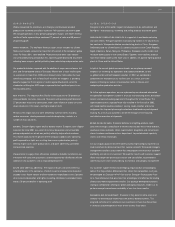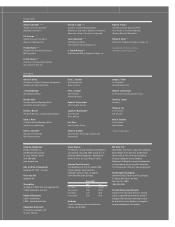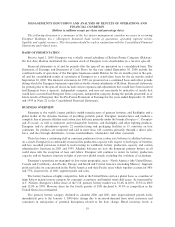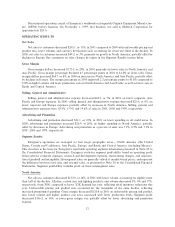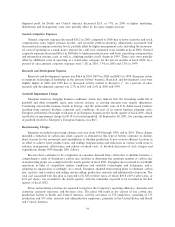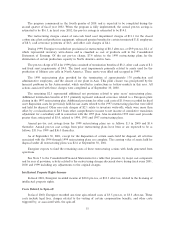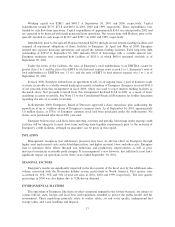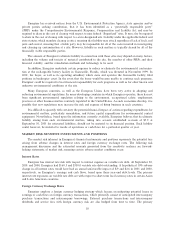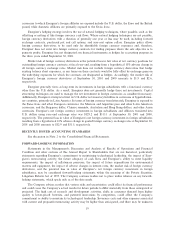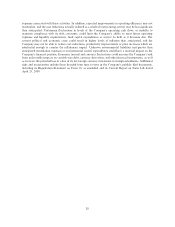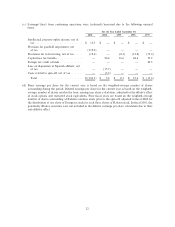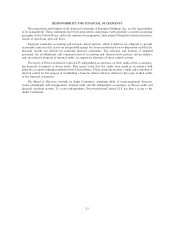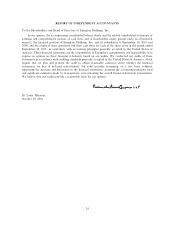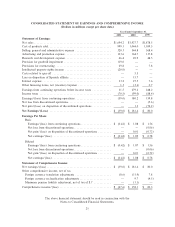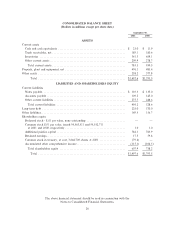Energizer 2001 Annual Report Download - page 19
Download and view the complete annual report
Please find page 19 of the 2001 Energizer annual report below. You can navigate through the pages in the report by either clicking on the pages listed below, or by using the keyword search tool below to find specific information within the annual report.Loss on Disposition of Spanish AÇliate
In Ñscal 2000, Energizer recorded a $15.7 pre-tax loss on the sale of its Spanish aÇliate prior to the spin-
oÅ. The loss was a non-cash write-oÅ of goodwill and cumulative translation accounts of the Spanish aÇliate.
Ralston recognized capital loss tax beneÑts related to the Spanish sale of $24.4, which are reÖected in
Energizer's historical Ñnancial statements and resulted in a net after-tax gain of $8.7 on the Spanish
transaction. Such capital loss beneÑts would not have been realized by Energizer on a stand-alone basis, thus
are not included in the Pro Forma Statement of Earnings for the year ended September 30, 2000, as presented
in Note 22 to the Consolidated Financial Statements.
Interest and Other Financial Items
Interest expense increased $5.9 in 2001 and $19.9 in 2000, reÖecting the cost of incremental debt
assumed by Energizer immediately prior to the spin-oÅ for a full year and for six months, respectively. Interest
expense for the last six months of 2001 declined $7.6 compared to the same six-month period in 2000, due to
lower average borrowings and lower interest rates.
Other Ñnancing-related costs increased $5.9 in 2001, reÖecting the discount on the sale of accounts
receivable under a Ñnancing arrangement and lower net exchange gains. Other Ñnancing-related costs
decreased $4.3 in 2000 compared to 1999, primarily due to lower foreign exchange losses, partially oÅset by
accounts receivable sales discounts.
Income Taxes
Income taxes, which include federal, state and foreign taxes, were 223.8%, 35.5% and 35.6% of earnings
from continuing operations before income taxes in 2001, 2000 and 1999, respectively. Earnings before income
taxes and income taxes include certain unusual items in all years, the most signiÑcant of which are described
below:
‚ In 2001, the provision for goodwill impairment of $119.0 has no associated tax beneÑt as the charge is
not deductible for tax purposes. The provisions for restructuring of $29.8 have an associated tax rate of
34.9%.
‚ In 2000, the income tax percentage was favorably impacted by the recognition of $24.4 U.S. capital
loss tax beneÑts related to the disposition of Energizer's Spanish aÇliate.
‚ Capital loss tax beneÑts of $16.6 were recognized in 1999 and were primarily related to prior years'
restructuring actions.
‚ In 1999, the income tax percentage was unfavorably impacted by pre-tax restructuring provisions that
did not result in tax beneÑts due to tax loss situations or particular statutes of a country.
Excluding unusual items, the income tax percentage was 45.7% in 2001, 41.8% in 2000 and 41.3% in
1999. The higher eÅective tax rate in 2001 reÖects pre-tax losses in foreign tax jurisdictions for which no tax
beneÑts were realized and goodwill charges for which there is no tax deduction. The year-over-year increase
was the result of the Ñxed dollar impact of these items being spread over a smaller earnings base.
LIQUIDITY AND CAPITAL RESOURCES
Cash Öows from continuing operations totaled $318.1 in 2001, $289.6 in 2000 and $337.2 in 1999. The
increase in cash Öows from continuing operations in 2001 was due primarily to signiÑcant inventory reduction
in 2001 compared to a signiÑcant inventory increase in 2000, and other working capital improvements in 2001,
partially oÅset by substantially lower cash earnings in 2001 and proceeds from sale of accounts receivable in
2000. The decrease in cash Öows from continuing operations in 2000 compared to 1999 was due primarily to
increased inventory levels and the realization of capital loss tax beneÑts in Ñscal 1999, partially oÅset by higher
cash earnings and proceeds from the sale of accounts receivable.
16



